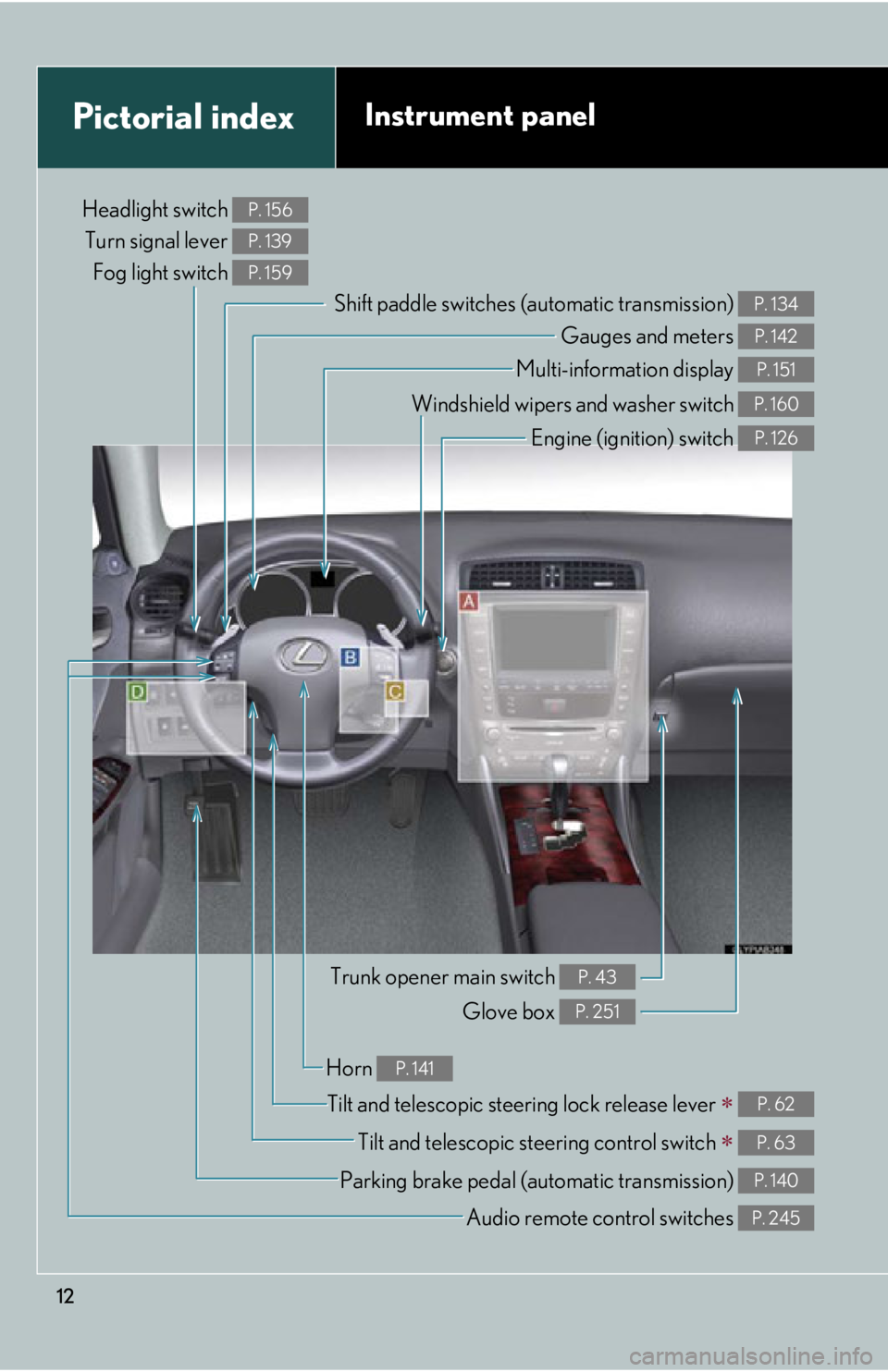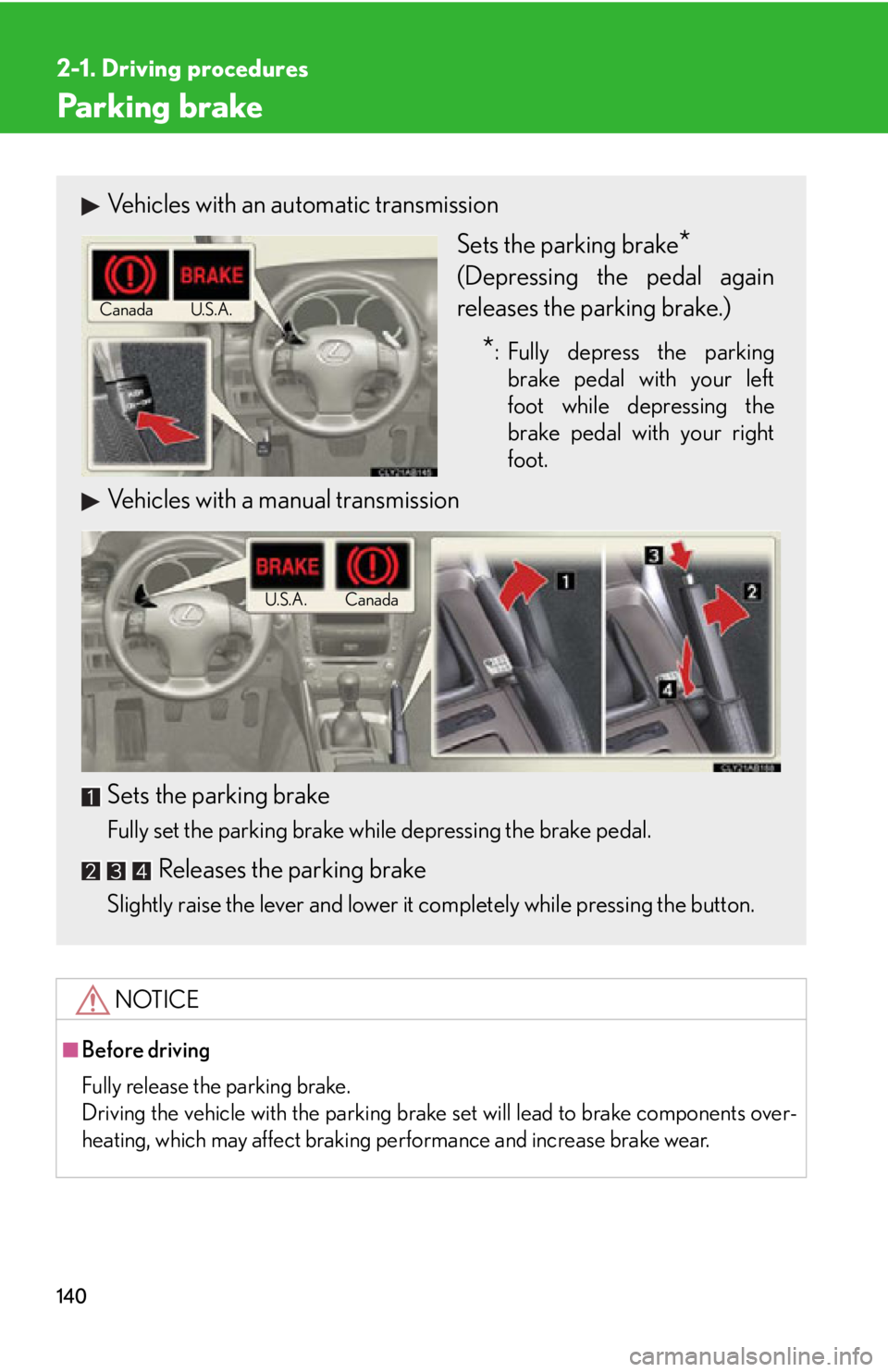brake light Lexus IS250 2009 Using the audio system / LEXUS 2009 IS350/250 OWNER'S MANUAL (OM53669U)
[x] Cancel search | Manufacturer: LEXUS, Model Year: 2009, Model line: IS250, Model: Lexus IS250 2009Pages: 488, PDF Size: 6.24 MB
Page 3 of 488

1
2
3
4
5
6
7
3
Manual transmission .................... 137
Turn signal lever ............................ 139
Parking brake ................................. 140
Horn...................................................... 141
2-2. Instrument cluster Gauges and meters ..................... 142
Indicators and warning lights................................................. 148
Multi-information display............. 151
2-3. Operating the lights and windshield wipers
Headlight switch ............................ 156
Fog light switch .............................. 159
Windshield wipers and washer............................................. 160
Headlight cleaner switch ........... 165
2-4. Using other driving systems Cruise control ................................ 166
Dynamic radar cruise control............................................. 170
Intuitive parking assist ................. 180
Driving assist systems.................. 186
PCS (Pre-Collision System) ............ 192 2-5. Driving information
Cargo and luggage ...................... 196
Vehicle load limits ......................... 199
Winter driving tips ...................... 200
Trailer towing ................................. 204
Dinghy towing (vehicles with an automatic
transmission) .............................. 205
Dinghy towing (vehicles with a manual transmission) ........... 206
3-1. Using the air conditioning system and defogger
Automatic air conditioning system ............................................. 210
Rear window and outside rear view mirror defoggers ............. 218
3-2. Using the audio system Audio system type ........................ 219
Using the radio.............................. 222
Using the CD player................... 229
Playing back MP3 and WMA discs.................................. 235
Optimal use of the audio system ............................................. 241
Using the AUX adapter ............ 244
Using the steering wheel audio switches ............................ 245
3Interior features
Page 11 of 488

11
C
Automatic transmission
Manual transmission
Seat heater switches
Seat heater/ventilator switches
P. 266
P. 269
Automatic transmission shift lever P. 131
Shift lock override button P. 415
Cigarette lighter
Ashtrays P. 264
P. 263
Manual transmission shift lever P. 137
Parking brake lever P. 140
Cigarette lighter
Ashtrays P. 264
P. 263
Seat heater switches
Seat heater/ventilator switches
P. 266
P. 269
: If equipped
Page 12 of 488

12
Pictorial indexInstrument panel
Headlight switch Turn signal lever Fog light switch P. 156
P. 139
P. 159
Shift paddle switches (automatic transmission) P. 134
Gauges and meters P. 142
Multi-information display P. 151
Windshield wipers and washer switch P. 160
Engine (ignition) switch P. 126
Trunk opener main switch P. 43
Glove box P. 251
Tilt and telescopic steering lock release lever P. 62
Tilt and telescopic steering control switch P. 63
Parking brake pedal (automatic transmission) P. 140
Audio remote control switches P. 245
Horn P. 141
Page 115 of 488

When driving2
115
2-1. Driving proceduresDriving the vehicle................... 116
Engine (ignition) switch ......... 126
Automatic transmission ......... 131
Manual transmission .............. 137
Turn signal lever ....................... 139
Parking brake ........................... 140
Horn ............................................. 141
2-2. Instrument cluster Gauges and meters ................ 142
Indicators and warning lights ......................................... 148
Multi-information display ...... 151
2-3. Operating the lights and windshield wipers
Headlight switch...................... 156
Fog light switch ........................ 159
Windshield wipers and washer ..................................... 160
Headlight cleaner switch...... 165 2-4. Using other driving
systems
Cruise control.......................... 166
Dynamic radar cruise control ..................................... 170
Intuitive parking assist ........... 180
Driving assist systems ............ 186
PCS (Pre-Collision System) ........ 192
2-5. Driving information Cargo and luggage ................ 196
Vehicle load limits ................... 199
Winter driving tips ................. 200
Trailer towing .......................... 204
Dinghy towing (vehicles with
an automatic
transmission) ........................ 205
Dinghy towing (vehicles with a
manual transmission) ......... 206
Page 117 of 488

117
2-1. Driving procedures
2
When driving
Starting on a steep uphillAutomatic transmission Firmly set the parking brake and shift the shift lever to D.
Gently depress the accelerator pedal.
Release the parking brake.
Manual transmission
With the parking brake firmly set and the clutch pedal fully
depressed, shift the shift lever into 1.
Lightly depress the accelerator pedal at the same time as gradu-
ally releasing the clutch pedal.
Release the parking brake.
■ Parking the vehicle
Automatic transmission
With the shift lever in D, depress the brake pedal.
Set the parking brake. ( P. 140)
Shift the shift lever to P. ( P. 1 3 1 )
Press the “ENGINE START STOP” switch and stop the engine.
Lock the door, making sure that you have the electronic key on
your person.
Manual transmission While depressing the clutch pedal, depress the brake pedal.
Set the parking brake. ( P. 140)
Shift the shift lever into N. ( P. 1 3 7 )
Press the “ENGINE START STOP” switch to stop the engine.
Lock the door, making sure that you have the electronic key on
your person.
STEP1
STEP2
STEP3
STEP4
STEP5
STEP1
STEP2
STEP3
STEP4
STEP5
STEP1
STEP2
STEP3
STEP1
STEP2
STEP3
Page 119 of 488

119
2-1. Driving procedures
2
When driving
CAUTION
■When starting the vehicle
With automatic transmission vehicles, always keep your foot on the brake pedal
while stopped with the engine running. This prevents the vehicle from creeping.
■When driving the vehicle
●Do not drive if you are unfamiliar with the location of the brake and accelerator
pedals to avoid depressing the wrong pedal.
• Accidentally depressing the accelerator pedal instead of the brake pedal will
result in sudden acceleration that may le ad to an accident that could result in
death or serious injury.
• When backing up, you may twist your bo dy around, leading to a difficulty in
operating the pedals. Make sure to operate the pedals properly.
• Make sure to keep a correct driving posture even when moving the vehicle only slightly, allowing you to depress the brake and accelerator pedals prop-
erly.
• Depress the brake pedal using your right foot. Depressing the brake pedal using your left foot may delay response in an emergency, resulting in an acci-
dent.
●Do not drive the vehicle over or stop the vehicle near flammable materials.
●With automatic transmission vehicles, do not let the vehicle roll backwards while
the shift lever is in a driving position, or roll forward while the shift lever is in R.
Doing so may cause the engine to stall or lead to poor brake and steering perfor-
mance, resulting in an accident or damage to the vehicle.
●If the smell of exhaust is noticed inside the vehicle, open the windows and check
that the trunk is closed. Large amounts of exhaust in the vehicle can cause driver
drowsiness and an accident, resulting in death or a serious health hazard. Have
the vehicle inspected by your Lexus dealer immediately.
●Do not under any circumstance s shift the shift lever to P, R or N (vehicles with an
automatic transmission) or R (vehicles with a manual transmission) while the vehi-
cle is moving.
Doing so can cause significant damage to the transmission system and may result
in a loss of vehicle control.
●Do not shift the shift lever to N while the vehicle is moving.
Doing so may cause the engine brake to not operate properly and lead to an
accident.
Page 121 of 488

121
2-1. Driving procedures
2
When driving
CAUTION
■When driving on slippery road surfaces
●Sudden braking, acceleration and steering may cause tire slippage and reduce
your ability to control the vehicle, resulting in an accident.
●Sudden changes in engine speed, such as engine braking caused by up-shifting
or down-shifting, may cause the vehicl e to skid, resulting in an accident.
●After driving through a puddle, lightly depress the brak e pedal to make sure that
the brakes are functioning properly. Wet brake pads may prevent the brakes from
functioning properly. If the brakes on on ly one side are wet and not functioning
properly, steering control may be af fected, resulting in an accident.
■When shifting the shift lever
With automatic transmission vehicles, be ca reful not to shift the shift lever with the
accelerator pedal depressed.
This may lead to unexpected rapid acceleration of the vehicle that may cause an
accident and result in death or serious injury.
■When the vehicle is stopped
●Do not race the engine.
If the vehicle is in any gear other than P (vehicles with an automatic transmission
only) or N the vehicle may accelerate suddenly and unexpectedly, and may cause
an accident.
●Do not leave the vehicle with the engine running for a long time.
If such a situation cannot be avoided, park the vehicle in an open space and
check that exhaust fumes do no t enter the vehicle interior.
●With automatic transmission vehicles, always keep a foot on the brake pedal
while the engine is running to prevent an accident caused by the vehicle moving.
Page 122 of 488

122
2-1. Driving procedures
CAUTION
■When the vehicle is parked
●Do not leave glasses, cigarette lighters, spray cans, or soft drink cans in the vehi-
cle when it is in the sun.
Doing so may result in the following.
• Gas may leak from a cigarette lighter or spray can, and may lead to a fire.
• The temperature inside the vehicle may cause the plastic lenses and plastic
material of eye glasses to deform or crack.
• Soft drink cans may fracture, causing the contents to spray over the interior of the vehicle, and may also cause a short circuit in the vehicle's electrical com-
ponents.
●Always apply the parking brake, shift the shift lever to P (vehicles with an auto-
matic transmission only), stop the engine and lock the vehicle.
Do not leave the vehicle unattend ed while the engine is running.
●Do not touch the exhaust pipe while the engine is running or immediately after
turning the engine off.
Doing so may cause burns.
●Do not leave the engine running in an area with snow build-up, or where it is
snowing. If snowbanks build up around the vehicle while the engine is running,
exhaust gases may collect and enter the vehi cle. This may lead to death or a seri-
ous health hazard.
■Exhaust gases
Exhaust gases include harmfu l carbon monoxide (CO) that is colorless and odor-
less. Inhaling exhaust gases may lead to death or a serious health hazard.
●If the vehicle is in a poorly ventilated ar ea, stop the engine. In a closed area, such
as a garage, exhaust gases may collect and enter the vehicle. This may lead to
death or a serious health hazard.
●The exhaust should be checked occasionally. If there is a hole or crack caused by
corrosion, damage to a joint or abnormal exhaust noise, be sure to have the vehi-
cle inspected and repaired by your Lexus dealer. Failure to do so may allow
exhaust gases to enter the vehicle, result ing in death or a serious health hazard.
Page 140 of 488

140
2-1. Driving procedures
Parking brake
NOTICE
■Before driving
Fully release the parking brake.
Driving the vehicle with the parking brake set will lead to brake components over-
heating, which may affect braking performance and increase brake wear.
Vehicles with an automatic transmission
Sets the parking brake
*
(Depressing the pedal again
releases the parking brake.)
*: Fully depress the parkingbrake pedal with your left
foot while depressing the
brake pedal with your right
foot.
Vehicles with a manual transmission
Sets
the parking brake
Fully set the parking brake while depressing the brake pedal.
Releases the parking brake
Slightly raise the lever and lower it completely while pressing the button.
Canada U.S.A.
Canada
U.S.A.
Page 157 of 488

157
2-3. Operating the lights and windshield wipers
2
When driving
AFS (vehicles with discharge headlights)
AFS (Adaptive Front-lighting System) improves visibility at intersections
and on curves by automatically adjusting the level of the headlights
according to vehicle speed and the degree of the tire angle that are con-
trolled by steering input.
Operates at speeds of 6 mph (10 km/h) or higher.
■ Deactivating AFS
How to switch: P. 2 6 0
“AFS OFF” turns on when the AFS is deactivated.
■Daytime running light system
To make your vehicle more visible to other drivers, the headlights turn on automati-
cally (at a reduced intensity) whenever the engine is started and the parking brake
is released. Daytime running lights are not designed for use at night.
■Headlight control sensor
The sensor may not function properly if an
object is placed on the sensor, or anything
that blocks the sensor is affixed to the wind-
shield.
Doing so interferes with the sensor detecting
the level of ambient light and may cause the
automatic headlight system to malfunction.